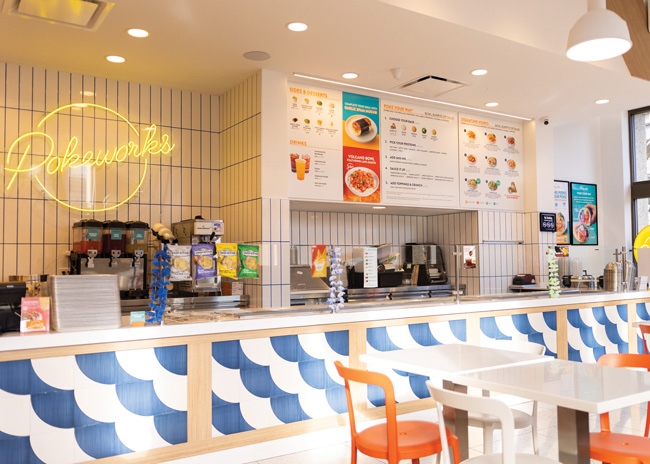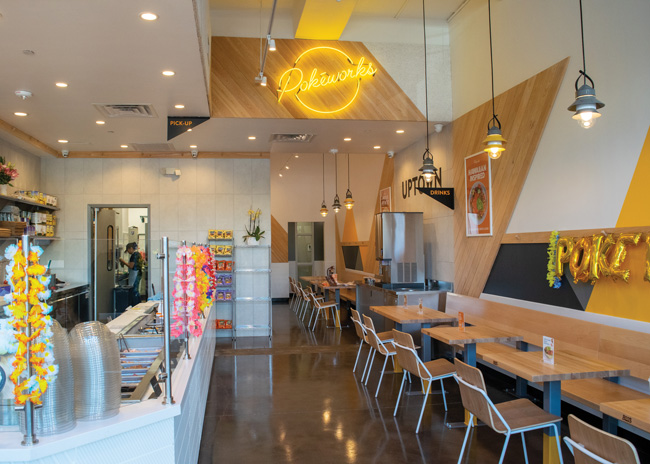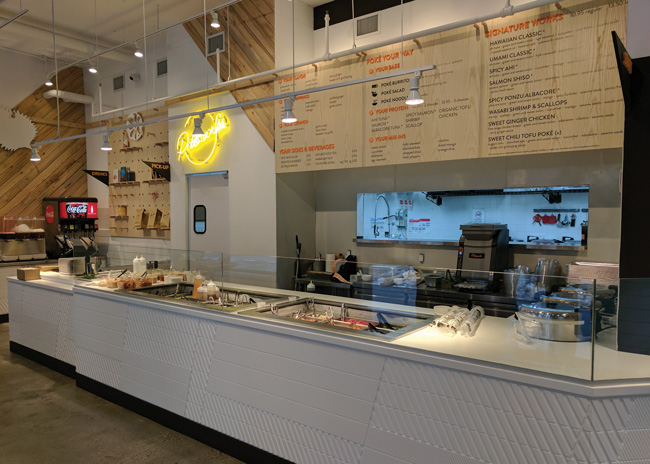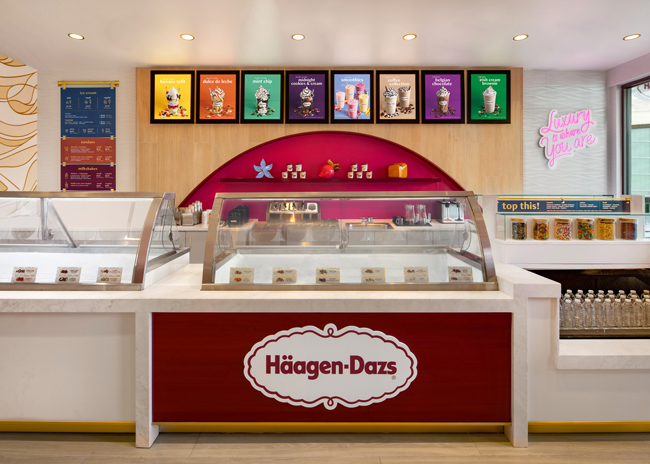In 2013, Peter Yang and his brother, Michael Wu, went to Hawaii to open a location of a Japanese hot pot concept. They left with an idea for an entirely different restaurant focused on Hawaiian poke — sliced raw sushi-grade fish served with rice and seasonings.
“During the construction process, we learned how to enjoy a nice bowl of poke as a meal,” says Yang. “Before that, poke had always been treated as an appetizer item [on the mainland], not as a meal itself. But in Hawaii, for decades you could go to the grocery store and get a pound of it with a scoop of rice or some mac and cheese. The idea became about sharing that island favorite on the mainland.”
So, in December 2016, the brothers, along with additional partners, opened the first Pokeworks in a 750-square-foot space in Midtown Manhattan. By placing the initial restaurant in such a competitive market, the founders were testing the concept, says CEO Yang. Not only did they want to know if poke was a good fit for a fast-casual operation, but they were also exploring consumer reaction to the dish.
While staff did have to educate guests about poke, lines began to form within a few months, partly due to a social media video that went viral.
With the concept thriving in New York, the company decided to expand the test, opening additional corporate stores in the San Francisco area and in Southern California, the home bases of two of the co-founders with restaurant experience. Those stores thrived, and just over a year after opening the first location, Pokeworks launched its franchise program. Today, the chain has grown to roughly 75 restaurants in the United States and Canada. All but seven of these are franchise locations.
 The open ceilings in Pokeworks help communicate a sense of airiness and lightness, which aligns with the chain’s healthy eating options. Images courtesy of Pokeworks
The open ceilings in Pokeworks help communicate a sense of airiness and lightness, which aligns with the chain’s healthy eating options. Images courtesy of Pokeworks
 Unlike in this photo of Pokeworks' previous prototype, the soda machine in the dining room has been removed entirely in the new prototype.
Unlike in this photo of Pokeworks' previous prototype, the soda machine in the dining room has been removed entirely in the new prototype.
Forced to Franchise
For many, franchising is the goal when they launch a restaurant. According to Yang, though, it wasn’t in Pokeworks’ plans. Instead, events compelled the chain to move in that direction. “We didn’t have the intention to franchise it. It wasn’t until we saw a lot of competition trying to use the exact same model that we said, ‘Uh-oh, it’s going to be harder to get good real estate in other markets.’ Plus, we had a lot of people knocking on our door, so there were a lot of good signs.”
A key factor in the success of the Pokeworks franchise is operational simplicity, says Yang. The concept doesn’t need a hood or any hot equipment other than electric rice cookers. This keeps the buildout costs low and allows the chain to be flexible with its real estate choices. “We could fit in a closet if we wanted. We just need a small prep kitchen,” says Yang.
Indeed, the chain has restaurants of all shapes and sizes, ranging from just 350 square feet in an office building food court to in-line locations measuring 2,000 square feet with seating for 15 to 20.
Value-Engineered Prototype
While Pokeworks has grown at a solid pace since it started franchising, there of course was a bump in the road during the pandemic. Not only did store growth slow, but construction and material costs spiked. The chain, says Yang, took this as an opportunity to reevaluate its design.
“Over the years we kind of got loose with it. We started spending in areas where it wasn’t necessary,” Yang recalls. “So, we really took a hard look at where our construction dollars were being spent and asked if it was really necessary. Can we achieve the same effect for guests for less? That’s what led to the creation of this value-engineered prototype.”
This prototype, says Yang, is significantly cheaper to build compared to earlier stores, while also focusing on key elements of the brand and the food.
In terms of the general feel, the new prototype isn’t a massive departure from legacy stores. Both want to communicate freshness and offer a crisp, comfortable environment where guests can enjoy their meal.
Both new and legacy stores feature several angled elements like wood sections that seemingly slice against the rest of the wall. According to Yang, this is a nod to the word “poke” itself, which means
“to cut” in Hawaiian.
Both also utilize neutral colors, such as whites and wood tones, to let the food stand out. While the layout of a restaurant may change based on its footprint, ideally, the make line is against the back wall of the front of the house, showcasing the vibrant reds, greens and oranges of poke to guests as they enter. The food wells themselves are angled slightly forward, making the food even easier to see, says Yang.
The ordering/assembly area is home to several changes in the redesign. The back wall, for example, is now made of white subway tile installed vertically. The grout for these tiles is in the chain’s signature blue — an inexpensive touch that helps reinforce the brand, Yang says.
Another change involves the face of the POS counter. Previously, this was clad in a custom material. Now, it is covered in stock blue and white tiles laid out in a wave pattern.
This approach — from expensive or custom elements to cheaper stock items — was applied in several areas of the restaurant.
These stock items are generally easier to install and have shorter lead times, says Yang. They’re also typically available from multiple distributors, which allows the chain to work with fewer vendors. The result is a simpler, faster construction process, he adds.
Another place where the chain reduced costs was the bathrooms. Pokeworks was using more expensive finishes and fixtures in this space than necessary, says Yang. In the redesign, the restrooms are 30% cheaper than before. “We don’t need to use premium materials where the customers don’t care about it. There are still creative ways to make it look good.”
For Pokeworks, these “creative ways” include using the POS area's subway tile in the bathrooms, too.While restaurants usually avoid this approach, Yang says, Pokeworks has taken steps to differentiate the spaces. While the subway tiles in the POS area are laid vertically, they’re horizontal in the bathrooms. At the same time, the grout for the bathroom tile is not blue, but a reddish orange.
Other key elements of the design include a neon sign of the chain’s logo, the Pokeworks name in script on an orange circle, representing a beach sunset. Similarly, the light fixtures hanging from the ceiling are slightly nautical in design, like something one might find at a marina, Yang says.
The chain isn’t done with these brand-centric touches. Pokeworks, says Yang, wants to do a better job communicating its story in future stores. This will likely be done through wall elements, like a timeline of the company’s history. The chain is also looking to incorporate some Hawaiian patterns into its prototype, such as traditional tattoo designs.
“We don’t want it to be too loud, but we want to give a nod and show respect to the culture that created this food,” says Yang.
 Key changes from the previous prototype, pictured here, included adding colorful tile to the front of the make line and upgrading to electronic menu boards.
Key changes from the previous prototype, pictured here, included adding colorful tile to the front of the make line and upgrading to electronic menu boards.
So Long to Soda (Sorta)
While the look and feel of the space got some adjustments in the redesign, much of the project focused on operational changes and even tweaks to the footprint.
One significant change: With more to-go and third-party delivery, Pokeworks added a pickup area for off-premises orders. Simultaneously, the chain reduced the size of its dining room by 20%. While many concepts are doing the same, this is a particularly easy change for fast-casual operations to make, says Yang. “People come, eat and go. They’re in and out in 15 minutes. We didn’t need a full dining room for that.”
Another big change in the redesign involves the chain’s beverages. In legacy stores, guests have access to a self-serve soda machine. With the new design, the soda machine has been removed entirely.
This results in obvious cost savings, but it also fits with the brand. While a burger joint may not be able to get away with such a change, it’s more acceptable at a healthy eating concept like poke. This change also lets the chain highlight some signature beverage options.
“We found that for our brand, people like our handcrafted drinks, which are made by our staff behind the counter. Otherwise, they just get something from the grab-and-go like a Diet Coke bottle or our Hawaiian Sun sodas,” says Yang.
Notably, the condiment station was placed in the same location as the soda machine in existing restaurants. Instead of making it a standalone design element, the condiments are now located on the POS counter, allowing customers to self-serve their sauces and toppings right after they place their order.
Eliminating the standalone soda/condiment station yields significant cost savings during construction. “Previously, we had to dig up the floor to put that plumbing in. That meant we’d have to trench across the dining hall,” says Yang. “Now we can use one continuous plumbing line instead of having that extra branch.”
 The custom finish on the face of the POS counter has been replaced by stock blue and white tiles, electronic menu boards have taken the spot of stating boards used in legacy restaurants.
The custom finish on the face of the POS counter has been replaced by stock blue and white tiles, electronic menu boards have taken the spot of stating boards used in legacy restaurants.
Nontraditional Adjustments
Of course, such significant construction changes only apply to restaurants with dining rooms. For nonstandard spaces like food courts, they simply don’t apply. The design of such locations focuses on the key brand elements including the neon logo sign and the display-focused assembly counter. Other pieces, like the angular wood features, can be edited out as needed.
One advantage of the Pokeworks model, says Yang, is its ability to operate successfully in such nonstandard spaces even when they are very small spaces or awkward. “Our prototype tells us our minimum requirements. What is the minimum dry shelving that we need? What is the minimum wall shelving above each stainless-steel table? What’s the minimum walk-in size? Every once in a while we have a 350-square-foot space in a weird triangle shape. So, we take these minimum approaches and try to fit it in like Legos.”
Such nonstandard locations, in fact, play a big role in Pokeworks' future growth plans. Operationally, the chain can work with prep and storage separate from the food assembly area. This has led Pokeworks to open a few food court locations along with two stores on college campuses. The chain is also actively bidding for spots in airports.
“That’s a gap we want to fill,” says Yang. “We think we can do it very well because our food travels really well. It’s healthy, it’s fresh and it’s something you can get
very quickly.”
 Measuring just 350 square feet, this office building food court location is Pokeworks’ smallest.
Measuring just 350 square feet, this office building food court location is Pokeworks’ smallest.
A Franchised Future
Notably, all these stores will be franchised going forward, says Yang. Through this route, the company believes it can grow its store count by 10% a year for at least the next few years.
While the chain is happy to have franchisees with restaurant experience, it’s not a requirement for Pokeworks. The simplicity of Pokeworks' operations — no hood, no cooks — makes this choice
possible, of course. But the chain is really focused on finding partners who know how to run a business and have a hospitality mindset, says Yang.
When it finds such partners, the chain wants them to be hands-on. “They can always build a team around it and become more of a manager, but for the first store, it’s important that there’s an owner/operator that runs it,” Yang says.
This commitment to finding the right people is reflected in the company’s footprint. While there are concentrations of locations in places like Texas and Southern California, it will open in far-flung markets like Coeur d’Alene, Idaho, if the right partner comes along.
When the right partners do come along, the company is ready to train them to know great poke by site, Yang says. The concept that began with the idea of introducing Poke to many people on the mainland believes, in short, that great poke is the key to its success.
“We have seminars for everybody in the company to understand exactly what a good poke bowl should look like. What is the best type of tuna? What is the best type of salmon? How can you identify it with your eyes?” says Yang. “We want our people to be experts at poke. That way everyone who works in our stores will understand if something is not perfect. If we have a good product, we believe the guests will come back. Sales fixes all.”
Snapshot
- Headquarters: Irvine, Calif.
- Concept owner: Beyond Restaurant Group
- Concept description: Fast-casual poke concept offering guests over 50,000 ways to customize their poke order to match their eating preferences including vegan, gluten-free and other mindful diets. Specialties include the Poke Burrito along with proprietary sauces.
- Unit count: Approximately 75
- Average check: $22.50
- Locations of new prototype: Astoria, Queens, New York; Atlanta; Fullerton, Calif.; Houston; Rochester Hills, Mich.; Toronto
- Opened: Updated prototype launched in mid 2024
- Size: Value engineered locations can range from 350 square feet to 1,500 square feet.
- Real estate: In-line, endcap, food court, nontraditional
- Design highlights: Contemporary design with bright, airy dining rooms; the make counter serves as a focal point, highlighting the vibrant colors and freshness of ingredients; design draws inspiration from Hawaiian islands, and the word “poke,” meaning to cut or slice.
- Build-out time: 12 weeks



